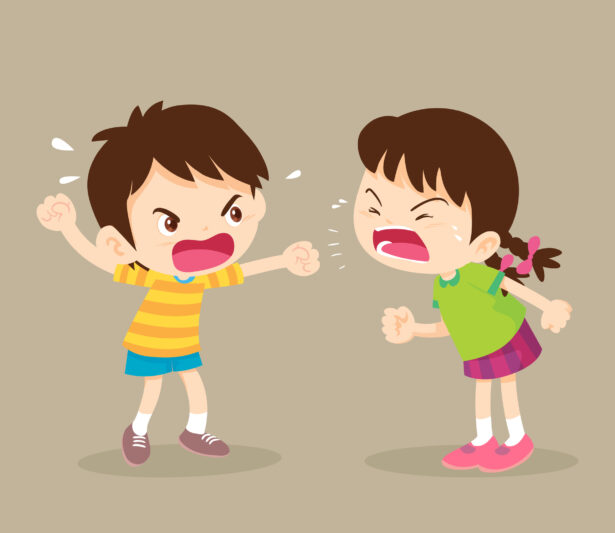Peer conflict is a normal part of human interaction, and children often begin to experience this type of conflict during childhood. These conflicts can occur for several reasons and may be verbal (i.e., spoken or written) or physical confrontations. As a parent, understanding some of the reasons for childhood peer conflict can help you better guide your children through these situations in a positive way.
The following are examples of why children may experience peer conflict:
- Competition: Humans can have feelings or desires that may compete with another’s feelings or desires. For example, when two children want to play with the same toy at the same time, a conflict could arise. Children often lack experience with communicating and interacting with others, so they may find it difficult to manage these types of competitive situations in appropriate and effective ways.
- Misunderstandings: This can occur when there has been a disagreement or a misinterpretation of a communication. Children’s communication skills are developing during childhood, so misunderstandings may occur often because they do not grasp the meaning or intent of an interaction.
- Social pressures: Navigating social situations can be challenging for children as their experiences with people, places, and interactions may be limited. Their responses can be a result of them trying to fit in, or identify, with a person or group of people.
- Emotions: A child’s immediate response to a situation will often directly mirror their emotions—this could be a positive or negative reaction. As children have experiences, they will learn how to develop their emotional control and, thus, their impulsive behavior.
Managing Peer Conflict: How you can help!
As children gain experiences in a variety of situations with diverse individuals, they may encounter situations that can create emotional distress within themselves. When children are emotionally upset, they need support from their important adults (e.g., parents/caregivers, teachers) to learn how to self-regulate their emotions and reactions. Research suggests that direct intervention in child peer conflicts may not be the most productive approach unless someone is in immediate danger. Instead, adults should help the child, or children, by guiding them through the interaction.
Here are a few ways adults can help children navigate these situations:
- Prompting: Prompting is the act of giving guidance to children on what to say next. For example, if two children are arguing over a toy, you could verbally prompt the child without the toy by saying, “Maybe you could try asking ‘May I borrow that toy?’”
- Questioning: Ask your child self-reflective questions, such as, “What do you think your friend is trying to say?” or “Are you sure you understand what your friend is trying to say?”
- Modeling: Model positive communication skills in your everyday interactions with your child and when children are present. Children learn how to handle conflict by watching and imitating how the adults around them act. If children see you handling conflicts in positive and productive ways, they will likely strive to do the same.
- Using “I” statements: Help your child understand that using statements with “I” instead of “you” can help others understand how the speaker feels without anyone placing blame. For example, you may encourage your child to say, “I felt mad when you took my ball without asking” instead of saying, “You took my ball to make me angry.” The first statement lets others know how the speaker is feeling without placing any blame and is usually a more effective communication strategy.
- Leaving: Walking away from a volatile or difficult situation can sometimes be the best resolution. Tell your child that there may be situations when they do not know what to say or when they feel that they may have an extreme emotional reaction (e.g., hitting their peer). Reassure them that, in these situations, it is often better to walk away.
Peer conflict is not all bad. It can be a useful experience that can help your child develop positive communication skills and problem-solving skills. Helping your child recognize what peer conflict is, why it might happen, and what strategies are available to help diffuse contentious situations is important. Teaching and using these skills can help you help your child resolve differences and develop healthy communication skills.
Additional Resources
Teaching Kids How to Deal with Conflict – Child Mind Institute: This article offers strategies and tips on helping children deal with conflict, and it is also available in Spanish. (en español) https://childmind.org/es/articulo/como-ensenar-a-los-ninos-a-lidiar-con-los-conflictos/
Recommendations for Parents on Managing Sibling Conflict and Aggression – University of New Hampshire: This resource provides parents with suggestions that are specific to managing sibling conflict.
Teach Kids About Conflict Resolution at Home- BrainPOP: This is a collection of videos and games that are grouped by age to help parents teach children about conflict resolution.
Thrive: The Thrive parent-education programs offer several resources and free trainings for parents and professionals. The universal Thrive parent-education programs (i.e., Take Root, Sprout, Grow, and Branch Out), supplemental modules, and mini-booster modules are free and available for all parents at http://thrive.psu.edu
References
Burdelski, M. (2020). ‘Say can I borrow it’: Teachers and children managing peer conflict in a Japanese preschool. Linguistics and Education, 59. https://doi.org/10.1016/j.linged.2019.04.002
Cao, Y., Wang, H., Lv, Y., & Xie, D. (2023). The influence of children’s emotional comprehension on peer conflict resolution strategies. Frontiers in Psychology, 14. https://doi.org/10.3389/fpsyg.2023.1142373
Chung, T.-Y., & Asher, S. R. (1996). Children’s goals and strategies in peer conflict situations. Merrill-Palmer Quarterly, 42(1), 125–147. http://www.jstor.org/stable/23090523
Smith-Schrandt, H., Ojanen, T., Gesten, E., Feldman, M., & Calhoun, C. (2011). Beyond situational ambiguity in peer conflict: Unique and combined effects of cues from an antagonist and a best friend. Child Development, 82(6), 1921-37. https://doi.org/10.1111/j.1467-8624.2011.01664.x.

